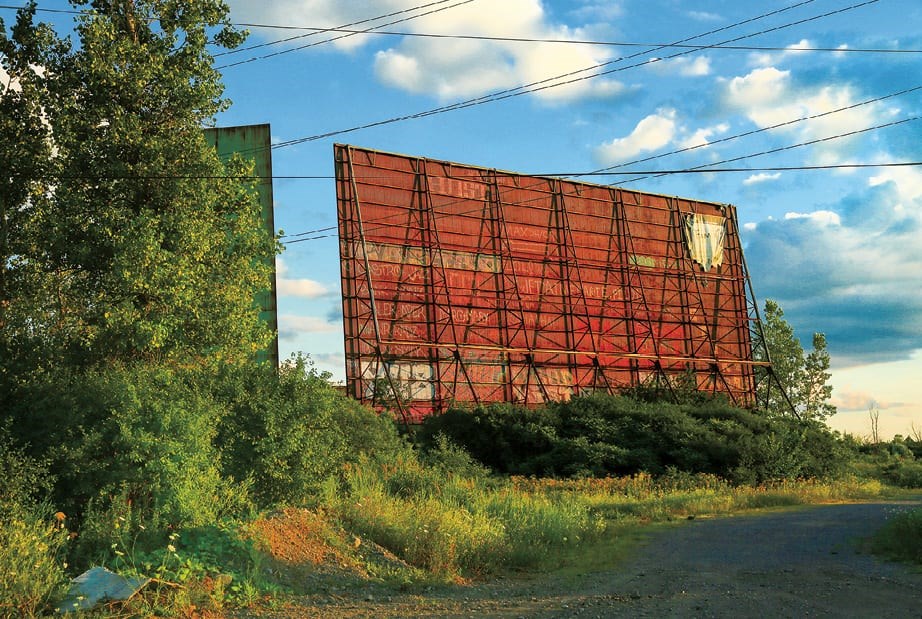A mere $12 million, and it's yours
BY GLORIA J. KATCH Special to the VOICE
Those who are nostalgic about movies and particularly drive-in theatres may have groaned recently when cruising the internet for Can-View drive-in listings. Shortly after displaying its website, the internet, in its usual connect-the-dots way, might well show a Remax Niagara advertisement—the Niagara landmark since 1983 is up for sale.
However, a spokesperson for the drive-in, who wishes to remain unnamed, assured the Voice that the four-theatre outdoor complex won’t disappear overnight. The listed price is $12 million dollars. The 84-acre parcel includes 20 acres of highway commercial front, but is also zoned agricultural and can be subdivided, so someone may purchase the property without necessarily dropping the final curtain on this slice of local cinema history.
The American phenomena of outdoor drive-ins began as early as 1910, but the first patented one was opened by Richard Hollingshead, in New Jersey. According to the New York Film Academy, Hollingshead advertised his drive-in as a place where “the whole family is welcome, regardless of how noisy the children are.” The success of his drive-in resulted in more drive-ins popping up faster than buttered popcorn in the 1950s and 1960s, with the Baby Boomer generation their biggest fans. Moms and dads loved the fact that they could take their children already clad in their fuzzy pyjamas. (From personal experience, this attire doesn’t quite work as well when you’re an adult.) Outdoor theatres occasionally became popular hangouts for teens on date nights, which resulted in more action, drama and partying inside the vehicles than on the screen. Family and friends gathering together under the stars meant there were many parts of the show that were missed, a bonus for the industry, as one often had to see the show twice.
Eventually, the drive-in became as traditional as apple pie, and many movies scenes depicted scenes at the drive-in. (It was like watching yourself on screen—a giant selfie.) That slice of life eventually made its way into Canada, and more specifically Ontario. The first drive-in, known as the Skyway, opened in 1946 in Stoney Creek, but was unfortunately torn down in 1975. As of last year, Canada still had 66 drive-ins, with some 25 located in Ontario. In their heyday, there were at least four drive-ins located in the Niagara area, including the Hollywood in Niagara Falls, The Lakeshore in St. Catharines, Mustang Drive-in in Fort Erie, and the Welland Drive-in, located in Dain City. The latter was torn down, and later the Can-View was built in the early ‘80s. The Can-View is the only drive-in left in Niagara, and boasts in excess of a 2,000-car capacity and spacious snack bar area. With the installation of new sound speakers and heaters, the outdoor theatrical experience extended the season for a few weeks. New projection systems allowed shows to continue even in the rain. Just don’t forget the bug spray.
The Can-View drive-in in 1996 became the subject of its own movie and urban legend, when a rare storm and tornado-velocity winds touched down, destroying one of its screens. At that time, the movie Twister was coincidentally playing on the next screen later that evening. The rumors led St. Catharines filmmaker Jay Cheel to create a short film nearly 20 years later, which made its debut at the Toronto International Film Festival.
With the downsizing of many vehicles to save fuel, and new 3D and surround-sound technology in traditional theaters, drive-ins have lost some of their appeal. Marketing departments have tried to compensate by showing classics, and typically double features. On long weekends and holidays, drive-ins celebrate with all-nighters showing three and four movies, which gives customers a big bang for their buck. Each screen often features a certain genre for those looking to view according to their mood or favourites. There are also “carload” nights during the week, and other deals that still make people hop into their cars, and head to the show. The pre-commercial cartoon advertising of their famous hotdogs is a mouth-watering blast from the past, and the snacks and refreshments at the Can-View are arguably more reasonably priced than regular theatre fare—if any theatre snacks can be called reasonably priced.
While drive-ins have somewhat faded, the New York Film Academy notes that US facilities that are 15 acres or larger do better business than smaller operations.
In 2015, the Financial Post reported Canada that the Canadian drive-ins that still remain are likely to perform well as long as multiplexes do well. While many drive-ins have been paved over and replaced by businesses, parking lots, and malls, the Post’s observation is worth holding onto, because there’s nothing iconic or legendary about another strip mall along Highway 20. Try carrying a cooler and wearing pajamas there—not a pretty picture.



